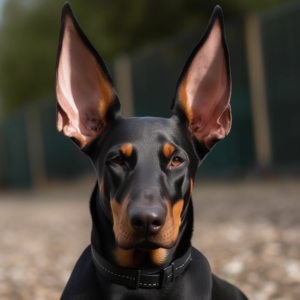In the world of dog breeding, certain practices have sparked controversy and debate over the years. One such practice is ear cropping, a procedure commonly associated with Doberman Pinschers. In this blog post, we will delve into the definition of ear cropping and explore its historical significance in relation to Dobermans.
Definition of Ear Cropping in Doberman Pinschers
Ear cropping is a cosmetic surgical procedure that involves removing a portion of a dog’s outer ear, often performed on Doberman Pinschers for aesthetic purposes. This procedure is typically done when the puppy is between 7 and 12 weeks old. The ears are then bandaged and taped in an upright position to encourage them to stand erect as they heal.
Brief History of Ear Cropping in Dobermans
The practice of ear cropping in Doberman Pinschers dates back several decades. Originally, the procedure served a practical purpose: it was believed to enhance the dog’s ability to hear and locate sounds. Additionally, it was thought to provide protection against potential injuries during hunting or guarding activities.
Ear cropping gradually became associated with Dobermans due to their working dog heritage and the desire to maintain a certain appearance. It became a common practice among breeders and enthusiasts, eventually evolving into a standard feature in the breed’s conformation shows.
Over time, however, the reasons behind ear cropping shifted from practicality to aesthetics. The cropped ears became synonymous with the breed’s distinctive look, contributing to its recognition and popularity worldwide.
Today, ear cropping remains a controversial subject, with differing opinions on its necessity and ethical implications. Let’s explore these perspectives in more detail in the upcoming sections of this blog post.
Stay tuned for our next blog post where we will discuss the traditional reasons for cropping Doberman ears and the role of ear cropping in breed standards and conformation shows.
Unveiling Cultural and Historical Perspectives of Cropping Doberman Ears

The practice of cropping Doberman ears has captured attention and sparked debate among dog enthusiasts and animal welfare advocates alike. In this blog post, we will explore the cultural and historical perspectives surrounding ear cropping in Doberman Pinschers. Understanding these perspectives can shed light on the traditional reasons behind this controversial practice and its role in breed standards and conformation shows.
Traditional Reasons for Cropping Doberman Ears
Historically, the traditional reasons for cropping Doberman ears were rooted in practicality and function. It was believed that cropped ears enhanced the dog’s ability to hear and locate sounds, particularly in their roles as working dogs. Additionally, it was thought that cropped ears provided protection against potential injuries during hunting or guarding activities.
Moreover, some proponents argue that cropped ears give Dobermans a regal appearance and make them look more “like a Doberman.” Supporters believe that the aesthetics of cropped ears conform to the breed’s distinct look, contributing to their recognition and popularity.
Role of Ear Cropping in Breed Standards and Conformation Shows
Ear cropping became closely associated with Doberman Pinschers due to its historical significance in the breed’s development and recognition. The cropped ear look became a defining feature of the Doberman breed, emphasized in breed standards and conformation shows.
Breed standards are guidelines that describe the ideal characteristics and appearance of a specific breed. In the case of Dobermans, many breed standards still call for cropped ears, although this requirement varies across different kennel clubs and countries. In conformation shows, which assess a dog’s adherence to breed standards, Dobermans with cropped ears have historically been favored, reinforcing the practice within the show ring.
However, it is worth noting that attitudes towards ear cropping have evolved over time, and breed standards are not static. Some kennel clubs and organizations, in response to changing societal views and animal welfare concerns, have revised their breed standards to allow for natural ears in Dobermans.
Stay tuned for our next blog post where we will delve into the controversies surrounding ear cropping, including ethical considerations and health implications. By exploring these controversies, we can gain a holistic understanding of this practice and the diverse perspectives surrounding it.
Unveiling the Perceived Benefits of Cropping Doberman Ears

In our previous blog post, we explored the cultural and historical perspectives surrounding ear cropping in Doberman Pinschers. Continuing the discussion, this blog post will focus on the perceived benefits associated with cropping Doberman ears. While it is important to understand these perspectives, it is equally essential to consider the diverse viewpoints and ethical considerations surrounding this practice.
Improved Appearance and Aesthetics
One of the main reasons why some people advocate for cropping Doberman ears is the belief that it enhances the dog’s appearance and aesthetics. Proponents argue that cropped ears create a more distinctive and assertive look, giving Dobermans a sleek and powerful presence. The cropped ear look is often associated with the breed’s image of strength and alertness.
Furthermore, supporters believe that cropped ears give Dobermans a more symmetrical and balanced facial profile. They argue that the upright, pointed ears contribute to the overall elegance and grace of the breed. For some owners, the aesthetic appeal of cropped ears is a significant factor in their decision to pursue this procedure.
Alleged Enhancement of Breed Characteristics
Another perceived benefit of cropping Doberman ears is the alleged enhancement of specific breed characteristics. Some proponents argue that cropped ears help improve the dog’s ability to communicate and express themselves through ear movements. They claim that cropped ears enable better visibility of ear positioning, making it easier for handlers and trainers to interpret the dog’s mood and intentions.
Furthermore, it is believed by some that cropped ears enhance the Doberman’s hearing ability. The upright positioning of the ears is thought to optimize sound reception and localization, which could be beneficial in various working roles and activities.
It is worth noting, however, that scientific evidence supporting these claims is limited. While anecdotal accounts exist, the consensus among veterinary professionals is that cropping Doberman ears does not provide any functional advantage in terms of communication or hearing ability.
Conclusion
The perceived benefits associated with cropping Doberman ears primarily revolve around improved appearance and aesthetics, as well as alleged enhancements to breed characteristics. However, it is important to approach these claims with critical thinking, considering the evolving attitudes towards animal welfare and ethical considerations surrounding this practice.
In our next blog post, we will delve into the controversies and ethical considerations surrounding ear cropping in Doberman Pinschers. By exploring both sides of the debate, we can gain a more holistic understanding of this issue and make informed decisions regarding the well-being of our canine companions.
Unveiling the Controversies Surrounding Ear Cropping in Doberman Pinschers

In our previous blog posts, we explored the historical and cultural perspectives as well as the perceived benefits of ear cropping in Doberman Pinschers. However, it is crucial to delve into the controversies surrounding this practice and address the ethical concerns, health implications, and legal considerations associated with ear cropping.
Ethical Concerns and Animal Welfare
One of the main points of contention surrounding ear cropping is the ethical concerns it raises regarding animal welfare. Critics argue that the procedure is unnecessary and imposes pain and suffering on the dog for purely cosmetic reasons. They believe that altering a dog’s appearance through surgical procedures should only be done for medical reasons or in the best interest of the animal’s health.
Furthermore, opponents of ear cropping emphasize that dogs have an inherent right to live free from unnecessary harm and discomfort. They argue that cosmetic procedures, such as ear cropping, prioritize human aesthetics over the well-being and natural attributes of the animal.
Advocates for animal welfare argue that there are alternative methods to enhance a Doberman’s appearance without resorting to surgery, such as promoting responsible breeding practices and focusing on proper training and socialization.
Health Implications and Risks Associated with Ear Cropping
Another significant controversy surrounding ear cropping is the potential health implications and risks it poses to the dog. The surgical procedure itself carries inherent risks, including anesthesia complications, infection, bleeding, and poor wound healing. Post-operative care is also crucial to prevent complications and ensure the dog’s well-being during the healing process.
Additionally, critics argue that cropped ears may leave the dog more vulnerable to certain health issues. Since the natural function of the ear has been altered, there is a possibility of decreased airflow and increased susceptibility to ear infections. The removal of protective ear flaps may also expose the inner ear to potential injury or foreign objects.
While some supporters of ear cropping argue that it can prevent certain ear-related problems, such as hematomas or injuries during working activities, scientific evidence supporting these claims is limited. The general consensus among veterinary professionals is that the risks and potential complications associated with ear cropping outweigh any potential benefits.
Legal Considerations and Regulations
The legality of ear cropping varies across different jurisdictions and countries. In some regions, ear cropping is completely prohibited except for medical reasons, while in others, it remains a common practice. Laws and regulations regarding ear cropping aim to strike a balance between individual freedoms, cultural practices, and animal welfare concerns.
It is essential for dog owners and breeders to familiarize themselves with the specific legal considerations and regulations in their area before making any decisions regarding ear cropping. Violating these regulations can result in legal consequences and penalties.
Conclusion
The controversies surrounding ear cropping in Doberman Pinschers revolve around ethical concerns, animal welfare considerations, health implications, and legal considerations. As responsible pet owners and advocates for our furry friends, it is essential to critically examine these issues and prioritize the well-being and natural attributes of our canine companions.
In our next blog post, we will explore alternative methods to enhance a Doberman’s appearance and discuss the importance of responsible breeding practices and proper care to ensure the overall health and happiness of our beloved pets.
Alternatives to Ear Cropping

Embracing Natural Ear Appearance and Breed Diversity
One of the main alternatives to ear cropping is embracing the natural appearance of a Doberman’s ears. This approach celebrates the breed’s diversity and respects their individual characteristics.
Doberman Pinschers come in various coat colors and ear types, including both natural floppy ears and naturally erect ears. Each variation adds to the uniqueness and beauty of the breed. By appreciating the natural appearance of Dobermans, we can promote breed diversity and discourage unnecessary surgical alterations.
Furthermore, embracing natural ear appearance aligns with the principles of animal welfare and ethical treatment. It allows dogs to express their natural behaviors, enhances their communication abilities, and preserves their overall well-being.
Training and Socialization as Alternatives to Enhance Temperament and Aggression Control
Rather than relying on cosmetic procedures like ear cropping to enhance a Doberman’s temperament and control aggression, training and socialization provide effective and humane alternatives.
Proper training methods, conducted by experienced professionals or under their guidance, help shape a Doberman’s behavior and instill desirable traits such as obedience, socialization, and self-control. Positive reinforcement techniques, rewards-based training, and consistent guidance can lead to a well-behaved and balanced dog.
Additionally, socialization plays a crucial role in shaping a Doberman’s temperament. Exposing them to a variety of environments, people, animals, and situations from a young age helps them develop into confident and well-adjusted adults. Well-socialized Dobermans are more likely to exhibit good behavior, have better impulse control, and be less prone to aggression.
Investing time and effort into training and socializing a Doberman can result in a strong bond between the dog and its owner, while also promoting positive interactions with other animals and humans.
Conclusion
Ear cropping is a controversial practice, but there are alternatives that prioritize the well-being and natural attributes of Doberman Pinschers. Embracing their natural ear appearance promotes breed diversity and respects the individual characteristics of each dog. Training and socialization are effective alternatives to enhance temperament, control aggression, and promote a positive relationship between the dog and its owner.
By exploring these alternatives, we can contribute to a more compassionate and responsible approach to caring for our Doberman companions.
Public Opinion and Changing Attitudes
Shifting Societal Views on Cosmetic Surgeries for Pets
In recent years, there has been a noticeable shift in societal views regarding cosmetic surgeries for pets, including procedures like ear cropping. More and more people are questioning the necessity and ethical implications of altering an animal’s appearance for non-medical reasons.
As society becomes increasingly aware of animal welfare issues, the demand for more humane treatment of animals has gained momentum. People are now recognizing that cosmetic surgeries, such as ear cropping, can cause unnecessary pain and potential complications for our beloved pets.
Veterinary organizations, animal rights groups, and ethical breeders have been at the forefront of this changing landscape, advocating against cosmetic surgeries and promoting natural attributes in animals. They emphasize the importance of preserving the physical integrity and well-being of our furry companions.
Influence of Social Media and Awareness Campaigns
One significant factor contributing to the changing attitudes towards cosmetic surgeries for pets, including ear cropping, is the influence of social media and awareness campaigns. The widespread use of platforms like Instagram, Facebook, and Twitter has provided a space for animal lovers and activists to voice their concerns and educate others about the ethical considerations surrounding these procedures.
Social media influencers, celebrities, and organizations dedicated to animal welfare have played a crucial role in raising awareness and promoting alternative approaches to pet care. They use their platforms to share stories, images, and educational content that shed light on the potential harm inflicted by cosmetic surgeries.
Awareness campaigns, both online and offline, have also helped shape public opinion. These campaigns often highlight the unnecessary pain and risks associated with procedures like ear cropping, urging pet owners to reconsider these practices. They emphasize the importance of embracing natural beauty and respecting animals’ well-being.
As public awareness continues to grow, it is likely that more pet owners will choose to forgo cosmetic surgeries and opt for alternatives that prioritize the welfare and natural attributes of their furry companions.
Conclusion
Public opinion regarding cosmetic surgeries for pets, including ear cropping, is undergoing a significant transformation. Shifting societal views are challenging the necessity and ethics of altering an animal’s appearance for non-medical reasons. The influence of social media and awareness campaigns has played a crucial role in raising awareness and educating the public about the potential harm caused by these procedures.
As we continue to evolve in our understanding of animal welfare, it is important to recognize that pets deserve to be treated with compassion and respect. By embracing natural beauty and promoting alternatives to cosmetic surgeries, we can promote a more humane approach to pet care.
Conclusion
Recap of Key Points
In this blog post, we have explored the topic of shifting public opinion and changing attitudes towards cosmetic surgeries for pets, specifically focusing on procedures like ear cropping. Here are the key points discussed:
- Shifting Societal Views: There has been a noticeable shift in societal views regarding cosmetic surgeries for pets. More people are questioning the necessity and ethical implications of altering an animal’s appearance for non-medical reasons.
- Animal Welfare Concerns: Veterinary organizations, animal rights groups, and ethical breeders are advocating against cosmetic surgeries, emphasizing the importance of preserving the physical integrity and well-being of animals.
- Social Media Influence: The influence of social media and awareness campaigns has played a significant role in raising awareness and educating the public about the potential harm caused by cosmetic surgeries. Platforms like Instagram, Facebook, and Twitter have provided a space for activists and animal lovers to voice their concerns and share educational content.
- Alternative Approaches: Awareness campaigns and influencers promote alternative approaches to pet care that prioritize the welfare and natural attributes of animals. They encourage pet owners to embrace natural beauty and make informed decisions about their pet’s well-being.
Encouraging Responsible Pet Ownership and Informed Decision-Making
As we conclude this discussion, it is essential to emphasize the importance of responsible pet ownership and informed decision-making. When considering cosmetic surgeries or any other procedures for our pets, it is crucial to:
- Educate Yourself: Take the time to research and understand the potential risks and benefits of any procedure before making a decision. Consult with reputable veterinarians and seek professional advice.
- Consider the Well-being of Your Pet: Prioritize the physical and emotional well-being of your pet. Ensure that any procedure you choose is in their best interest and not solely for cosmetic purposes.
- Promote Natural Beauty: Appreciate and celebrate the natural attributes of your pet. Embrace their uniqueness and avoid altering their appearance for non-essential reasons.
- Support Ethical Practices: Support veterinary organizations, animal rights groups, and ethical breeders who advocate for responsible pet care and discourage unnecessary cosmetic surgeries.
By adhering to these principles, we can contribute to a more compassionate and conscientious approach to pet ownership. Together, we can ensure that our furry companions receive the love, care, and respect they deserve.
Disclaimer: The information provided in this blog post reflects current trends and attitudes regarding cosmetic surgeries for pets, including ear cropping. It is important to consider professional advice and consult with veterinarians for personalized guidance and recommendations for your own pet.
Sources:
- NCBI – Tail Docking and Ear Cropping Dogs: Public Awareness
- Breed Expert – To Crop Or Not: The Debate on Doberman Ear Cropping
- The Smart Canine – Doberman Ear Cropping: Everything You Need to Know
- Wikipedia – Cropping (animal)
- AVMA – Welfare Implications of Ear Cropping-Dogs
- Tryfi Blog – Doberman Ear Cropping: Enhance Appearance and…
- RSPCA – Ear Cropping in Dogs
- Quora – Why is cropping a Doberman’s ears important?
- Tier 1 Vet – Why Do People Crop Dogs’ Ears? Things to Consider
- RSPCA – Ear cropping: Dogs need their ears – and here’s why
- American Kennel Club – Ear Cropping
- The Doberman Pinscher Club of America – History of Ear Cropping
